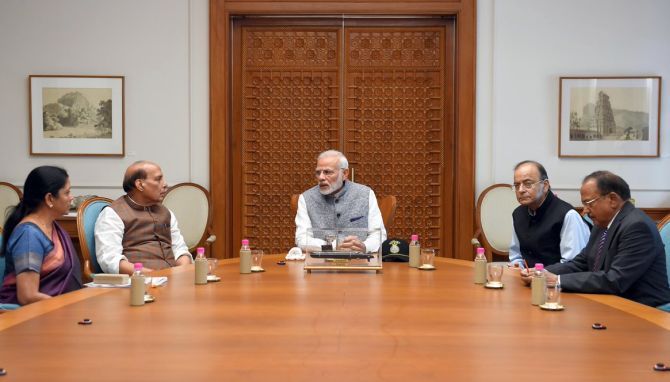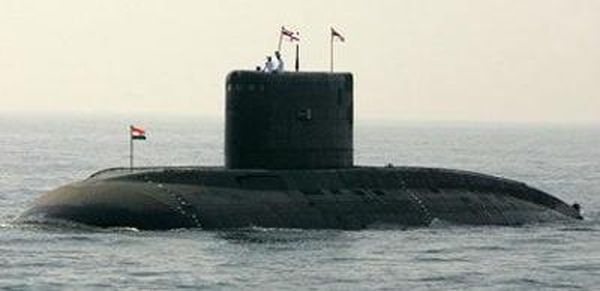 | « Back to article | Print this article |

Marking the country's nuclear triad, Indian nuclear submarine INS Arihant, or the 'destroyer of enemies' has successfully completed its first deterrence patrol, Prime Minister Narendra Modi announced on Monday and described it as a fitting response to those who indulge in 'nuclear blackmail'.
Modi, while addressing the Arihant crew, also warned enemies of the country not to 'resort to any audacity', asserting that India is a peace-loving country and does not instigate anyone but does not spare those who needle it.
"Our nuclear arsenal are not a part of an aggressive policy, but it is an important means for peace and stability. Peace is our strength, not our weakness. Our nuclear programme must be seen with regard to India's efforts to further world peace and stability," he said.

The development is a major achievement for the country, he said, adding that INS Arihant will help in protecting the country from external threats and contribute to the atmosphere of peace in the region.
'In an era such as this, a credible nuclear deterrence is the need of the hour. The success of INS Arihant gives a fitting response to those who indulge in nuclear blackmail,' Modi tweeted, in an veiled reference to Pakistan's often-repeated threat of nuclear encounter.
Apart from his address, Modi also posted a number of tweets, saying India's nuclear triad will be an important pillar of global peace and stability in the Indo-Pacific region.

Dubbing INS Arihant as the 'harbinger of fearlessness' for the country, Modi said, "Today is historic because it marks the completing of the successful establishment of the nuclear triad. India's nuclear triad will be an important pillar of global peace and stability."
The Army's Agni ballistic missiles and the Air Force's fighter jets are capable of carrying nuclear war heads. INS Arihant completes the maritime strike capability of the Navy.
The development assumes significance as India has two nuclear weapons states as its neighbours.
India's eastern neighbour China became a nuclear weapons state way back in the 1970s.

The Indian Ocean Region, crucial for India's strategic interests, has also been witnessing an increasing presence of Chinese ships and submarines.
The prime minister noted that the achievement has put India among a handful of countries having the capability to design, construct and operate a Strategic Strike Nuclear Submarine (SSBN).
Modi commended the commitment of soldiers, and the talent and perseverance of its scientists for transforming the scientific achievement of nuclear tests into establishment of an immensely complex and credible nuclear triad.
This, the prime minister said, dispelled all doubts and questions about India's capability and resolve in this regard.
Security expert Commodore C Uday Bhaskar (retired) said the completion of Arihant's first deterrence patrol signals the credibility of India's underwater nuclear deterrent capability.
"The first operational patrol of Arihant sent out a signal about India's strategic capability and resolve," he said.
India has put in place a 'robust' nuclear command and control structure, effective safety assurance architecture and strict political control, under its Nuclear Command Authority, a release issued by the Prime Minister's Office stated.
It has a doctrine of Credible Minimum Deterrence and No First Use, as enshrined in the decision taken by the Cabinet Committee on Security chaired by the then prime minister Atal Bihari Vajpayee on January 4, 2003, it added.
INS Arihant: A warship which can dive to 300 metres, remain under water for months
INS Arihant, the indigenously-built nuclear-propelled submarine that completed its first deterrence patrol, is capable of firing ballistic missiles and can stay under water for months.
The Strategic Strike Nuclear Submarine (SSBN) Arihant is a 6,000-tonne submarine with a length of 110 metres and a breadth of 11 metres.
The underwater warship is capable of carrying 12 K-15 submarine-launched ballistic missiles having a range of over 700 km.
It can dive to 300 metres and is powered with a 83 MW nuclear power reactor.
SSBNs are usually bigger in size and are powered by a nuclear reactor, as a result they can remain submerged for months without having to surface.
This allows them to travel farther and with greater stealth.
They are supposed to be the best guarantee for a second-strike capability in a possible nuclear exchange scenario.
India follows the policy of not using nuclear weapons first. INS Arihant was launched on July 26, 2009, the anniversary of Kargil War Vijay Diwas, by then Prime Minister Manmohan Singh.
Four years later, in August 2013, the submarine's atomic reactor was activated.
Since then, it has undergone extensive sea trials. It was quietly inducted in the Indian Navy in 2016.
It is another fine example of a joint mission of the scientists from the Defence Research and Development Organisation (DRDO) and the country's nuclear establishment. There are plans to induct Aridhaman, the second SSBN.
Photographs: Press Information Bureau
